University Report: Policy and Practice for Old Age - Delirium
VerifiedAdded on 2021/06/16
|19
|4575
|67
Report
AI Summary
This report focuses on the policy and practice for managing delirium in older adults, a condition characterized by disturbed mental states. It explores the aetiology and risk factors of delirium, including severe illness, infection, and medication use. The report reviews the Australian Government's health policy for delirium care, detailing assessment processes, including the Confusion Assessment Method (CAM), and the importance of involving family members. It examines the policy's impact on the health of older people, emphasizing both pharmacological and non-pharmacological treatments, such as the use of antipsychotics and the promotion of proper diet and sleep. The report suggests further policy development through staff education and context-specific intervention strategies. It concludes with a review of the evidence base, highlighting the use of evidence-based practices like Pool's algorithm and CAM assessments, while also acknowledging limitations such as the lack of a specific care structure. The report emphasizes the need for holistic care, family involvement, and continuous improvement in delirium management to enhance the quality of life for older adults.
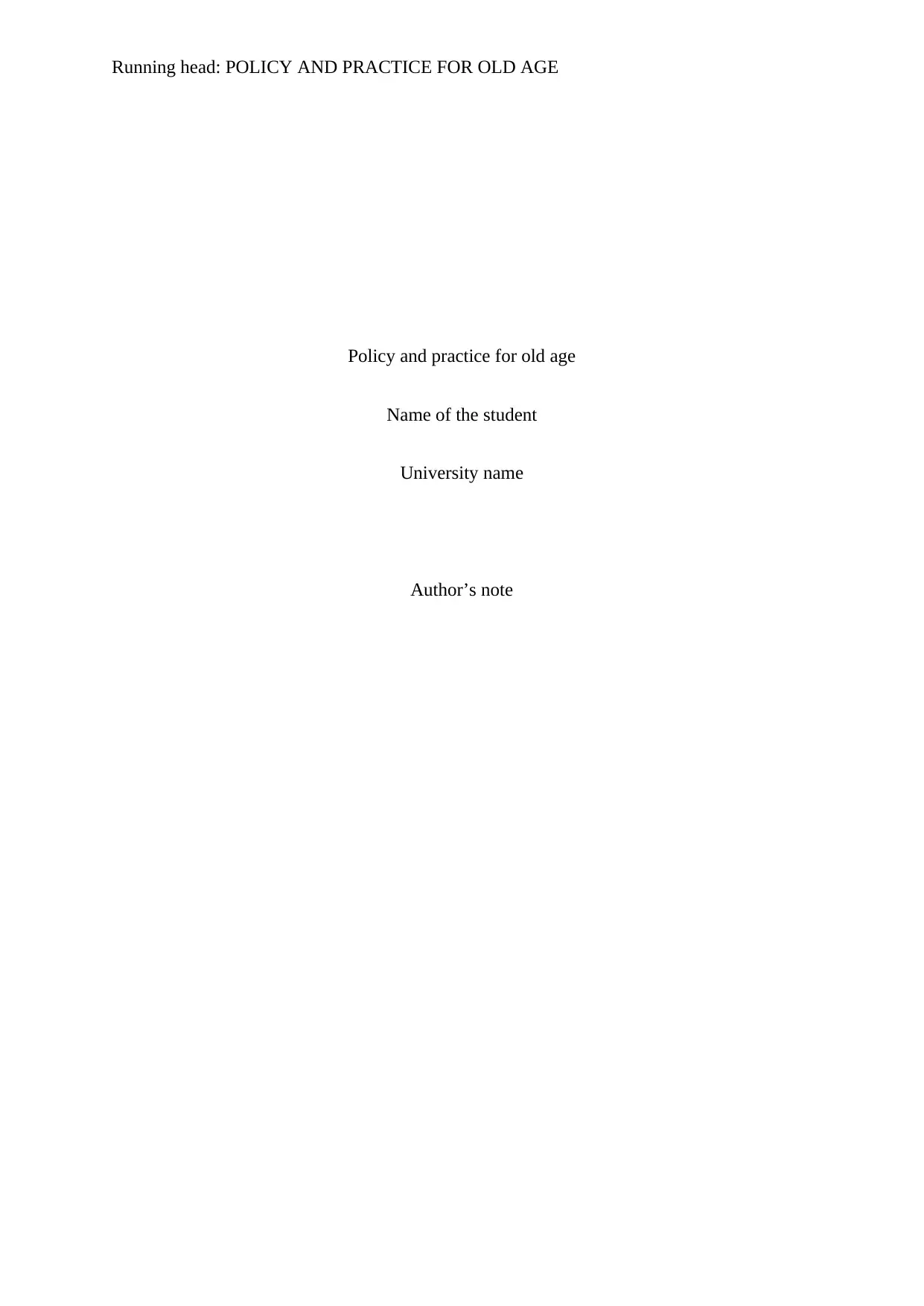
Running head: POLICY AND PRACTICE FOR OLD AGE
Policy and practice for old age
Name of the student
University name
Author’s note
Policy and practice for old age
Name of the student
University name
Author’s note
Paraphrase This Document
Need a fresh take? Get an instant paraphrase of this document with our AI Paraphraser
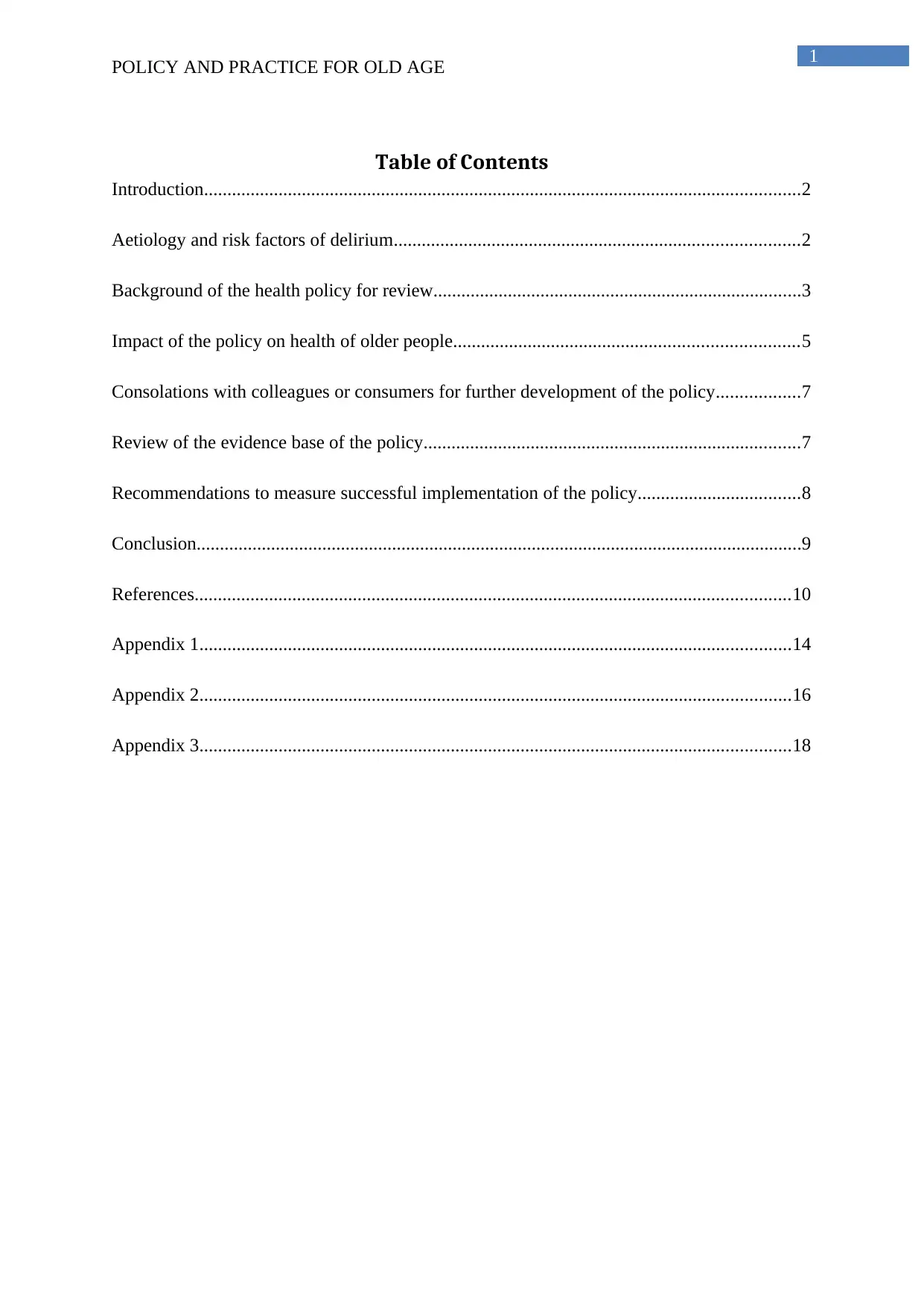
1
POLICY AND PRACTICE FOR OLD AGE
Table of Contents
Introduction................................................................................................................................2
Aetiology and risk factors of delirium.......................................................................................2
Background of the health policy for review...............................................................................3
Impact of the policy on health of older people..........................................................................5
Consolations with colleagues or consumers for further development of the policy..................7
Review of the evidence base of the policy.................................................................................7
Recommendations to measure successful implementation of the policy...................................8
Conclusion..................................................................................................................................9
References................................................................................................................................10
Appendix 1...............................................................................................................................14
Appendix 2...............................................................................................................................16
Appendix 3...............................................................................................................................18
POLICY AND PRACTICE FOR OLD AGE
Table of Contents
Introduction................................................................................................................................2
Aetiology and risk factors of delirium.......................................................................................2
Background of the health policy for review...............................................................................3
Impact of the policy on health of older people..........................................................................5
Consolations with colleagues or consumers for further development of the policy..................7
Review of the evidence base of the policy.................................................................................7
Recommendations to measure successful implementation of the policy...................................8
Conclusion..................................................................................................................................9
References................................................................................................................................10
Appendix 1...............................................................................................................................14
Appendix 2...............................................................................................................................16
Appendix 3...............................................................................................................................18

2
POLICY AND PRACTICE FOR OLD AGE
Introduction
The current assignment focuses upon the aspect of delirium within the elderly.
Delirium refers to a disturbed state of mind and is characterised by restlessness, illusions,
incoherence in speech, fever and other disorders. Delirium is often the result of fatigue or an
ecstatic mind. It could be stimulated by physical or mental trauma. Additionally, the
condition often requires frequent hospitalisations. The rate is immensely high where at least
10% of Australians aged over 70 had experienced emergency admissions for delirium care
(health.gov.au 2018). The state of delirium affects consciousness, attention as well as
memory within the patients. The older patients admitted with delirium in hospitals have low
recovery rate and are at increased risk of mortality (Maldonado, 2013). In 2006, the first set
of national clinical practice guidelines for management of delirium on older people was
developed.
The study here focuses upon currently developed policies and guidelines for the
management of delirium in older people. Some of the government based policies have been
revised further in order to provide a patient centred care. The evaluation of the policies also
highlights the various loopholes, which makes the appropriate implementation and
optimization of the policies impossible.
Aetiology and risk factors of delirium
The state of delirium is defined as a state of mental agitation and restlessness which is
characterised by a number of physical and mental anomalies. Some of the factors responsible
for causes delirium in a patient are- severe illness, infection, medication and use or
withdrawal of alcohol. The delirium is often characterised my improper sodium-potassium
balance in the blood. This could be often attributed to physical stress or anxiety within the
patient. As mentioned by Pendlebury et al. (2016), acute anxiety or trauma causes
POLICY AND PRACTICE FOR OLD AGE
Introduction
The current assignment focuses upon the aspect of delirium within the elderly.
Delirium refers to a disturbed state of mind and is characterised by restlessness, illusions,
incoherence in speech, fever and other disorders. Delirium is often the result of fatigue or an
ecstatic mind. It could be stimulated by physical or mental trauma. Additionally, the
condition often requires frequent hospitalisations. The rate is immensely high where at least
10% of Australians aged over 70 had experienced emergency admissions for delirium care
(health.gov.au 2018). The state of delirium affects consciousness, attention as well as
memory within the patients. The older patients admitted with delirium in hospitals have low
recovery rate and are at increased risk of mortality (Maldonado, 2013). In 2006, the first set
of national clinical practice guidelines for management of delirium on older people was
developed.
The study here focuses upon currently developed policies and guidelines for the
management of delirium in older people. Some of the government based policies have been
revised further in order to provide a patient centred care. The evaluation of the policies also
highlights the various loopholes, which makes the appropriate implementation and
optimization of the policies impossible.
Aetiology and risk factors of delirium
The state of delirium is defined as a state of mental agitation and restlessness which is
characterised by a number of physical and mental anomalies. Some of the factors responsible
for causes delirium in a patient are- severe illness, infection, medication and use or
withdrawal of alcohol. The delirium is often characterised my improper sodium-potassium
balance in the blood. This could be often attributed to physical stress or anxiety within the
patient. As mentioned by Pendlebury et al. (2016), acute anxiety or trauma causes
⊘ This is a preview!⊘
Do you want full access?
Subscribe today to unlock all pages.

Trusted by 1+ million students worldwide
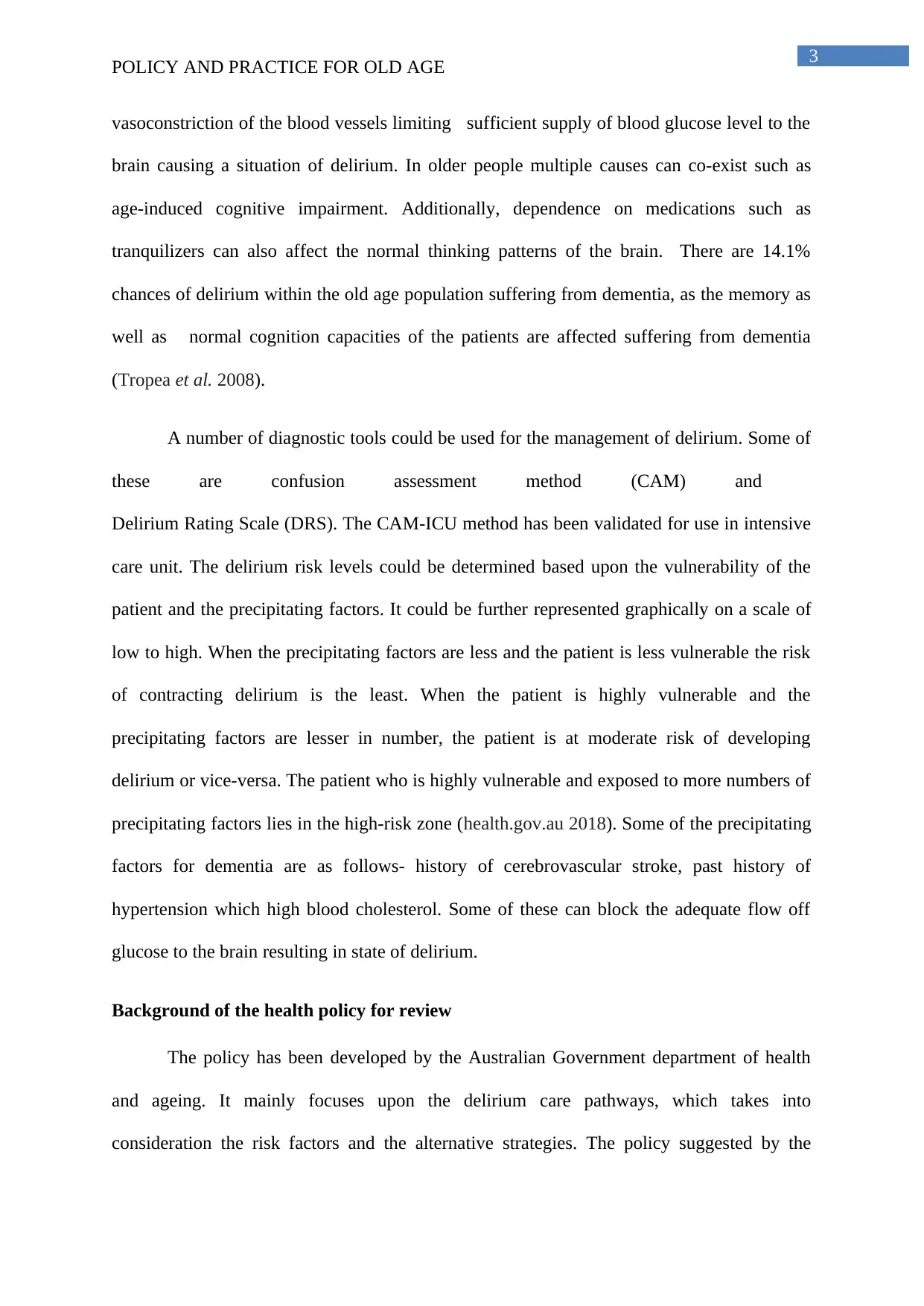
3
POLICY AND PRACTICE FOR OLD AGE
vasoconstriction of the blood vessels limiting sufficient supply of blood glucose level to the
brain causing a situation of delirium. In older people multiple causes can co-exist such as
age-induced cognitive impairment. Additionally, dependence on medications such as
tranquilizers can also affect the normal thinking patterns of the brain. There are 14.1%
chances of delirium within the old age population suffering from dementia, as the memory as
well as normal cognition capacities of the patients are affected suffering from dementia
(Tropea et al. 2008).
A number of diagnostic tools could be used for the management of delirium. Some of
these are confusion assessment method (CAM) and
Delirium Rating Scale (DRS). The CAM-ICU method has been validated for use in intensive
care unit. The delirium risk levels could be determined based upon the vulnerability of the
patient and the precipitating factors. It could be further represented graphically on a scale of
low to high. When the precipitating factors are less and the patient is less vulnerable the risk
of contracting delirium is the least. When the patient is highly vulnerable and the
precipitating factors are lesser in number, the patient is at moderate risk of developing
delirium or vice-versa. The patient who is highly vulnerable and exposed to more numbers of
precipitating factors lies in the high-risk zone (health.gov.au 2018). Some of the precipitating
factors for dementia are as follows- history of cerebrovascular stroke, past history of
hypertension which high blood cholesterol. Some of these can block the adequate flow off
glucose to the brain resulting in state of delirium.
Background of the health policy for review
The policy has been developed by the Australian Government department of health
and ageing. It mainly focuses upon the delirium care pathways, which takes into
consideration the risk factors and the alternative strategies. The policy suggested by the
POLICY AND PRACTICE FOR OLD AGE
vasoconstriction of the blood vessels limiting sufficient supply of blood glucose level to the
brain causing a situation of delirium. In older people multiple causes can co-exist such as
age-induced cognitive impairment. Additionally, dependence on medications such as
tranquilizers can also affect the normal thinking patterns of the brain. There are 14.1%
chances of delirium within the old age population suffering from dementia, as the memory as
well as normal cognition capacities of the patients are affected suffering from dementia
(Tropea et al. 2008).
A number of diagnostic tools could be used for the management of delirium. Some of
these are confusion assessment method (CAM) and
Delirium Rating Scale (DRS). The CAM-ICU method has been validated for use in intensive
care unit. The delirium risk levels could be determined based upon the vulnerability of the
patient and the precipitating factors. It could be further represented graphically on a scale of
low to high. When the precipitating factors are less and the patient is less vulnerable the risk
of contracting delirium is the least. When the patient is highly vulnerable and the
precipitating factors are lesser in number, the patient is at moderate risk of developing
delirium or vice-versa. The patient who is highly vulnerable and exposed to more numbers of
precipitating factors lies in the high-risk zone (health.gov.au 2018). Some of the precipitating
factors for dementia are as follows- history of cerebrovascular stroke, past history of
hypertension which high blood cholesterol. Some of these can block the adequate flow off
glucose to the brain resulting in state of delirium.
Background of the health policy for review
The policy has been developed by the Australian Government department of health
and ageing. It mainly focuses upon the delirium care pathways, which takes into
consideration the risk factors and the alternative strategies. The policy suggested by the
Paraphrase This Document
Need a fresh take? Get an instant paraphrase of this document with our AI Paraphraser

4
POLICY AND PRACTICE FOR OLD AGE
government in this regard provides a detailed process for the assessment of delirium. It
begins with identification of the patient suffering from delirium. This should be followed by
performing baseline cognitive assessments. The changes in the cognition and thinking
patterns of the patient should be identified. Based upon the results obtained the patient could
be put under gradual assessment test.
The policy guidelines, the detailed steps for the identification of the causes of
delirium. Some of the steps have been entailed below as – obtaining the history of the patient
regarding any recent changes in medication, dehydration, falls, infection, balder and bowel
function, past medical history, social history, alcohol history, dietary and fluid intake. The
information may be drafted from the general practitioners, carers and family members of the
patient (Vos et al. 2017). In order to ascertain the state of delirium within the patient some of
the vital signs should be checked such as temperature, pulse, blood pressure, respiratory rates
etc. Apart from mental state examination the skin surfaces of the patient could be tested for
the presence of dehydration (Oh et al. 2017). Additionally, urine retention, faecal impaction
are physical stressors which could enhance the state of the delirium in the patient. Some of
the tests could be conducted such as CT scan in order to confirm the presence of lesions due
to falls earlier as well as to rule out the presence of any internal damage. The policy also
places sufficient amount of importance on the management of delirium through involvement
of the family members of the patient. As suggested by Inouye (2018), provision of proper diet
along with rest and sleep can also help in relieving the pertinence of delirium within the
patient.
The article places sufficient importance upon the prevention strategies, which could
be further divided into clinical strategies for delirium care and environmental policies. The
environmental strategies may include controlling the exposure to light of the patient. as
mentioned by Timmons et al. (2017), adequate exposure to light during the day within
POLICY AND PRACTICE FOR OLD AGE
government in this regard provides a detailed process for the assessment of delirium. It
begins with identification of the patient suffering from delirium. This should be followed by
performing baseline cognitive assessments. The changes in the cognition and thinking
patterns of the patient should be identified. Based upon the results obtained the patient could
be put under gradual assessment test.
The policy guidelines, the detailed steps for the identification of the causes of
delirium. Some of the steps have been entailed below as – obtaining the history of the patient
regarding any recent changes in medication, dehydration, falls, infection, balder and bowel
function, past medical history, social history, alcohol history, dietary and fluid intake. The
information may be drafted from the general practitioners, carers and family members of the
patient (Vos et al. 2017). In order to ascertain the state of delirium within the patient some of
the vital signs should be checked such as temperature, pulse, blood pressure, respiratory rates
etc. Apart from mental state examination the skin surfaces of the patient could be tested for
the presence of dehydration (Oh et al. 2017). Additionally, urine retention, faecal impaction
are physical stressors which could enhance the state of the delirium in the patient. Some of
the tests could be conducted such as CT scan in order to confirm the presence of lesions due
to falls earlier as well as to rule out the presence of any internal damage. The policy also
places sufficient amount of importance on the management of delirium through involvement
of the family members of the patient. As suggested by Inouye (2018), provision of proper diet
along with rest and sleep can also help in relieving the pertinence of delirium within the
patient.
The article places sufficient importance upon the prevention strategies, which could
be further divided into clinical strategies for delirium care and environmental policies. The
environmental strategies may include controlling the exposure to light of the patient. as
mentioned by Timmons et al. (2017), adequate exposure to light during the day within

5
POLICY AND PRACTICE FOR OLD AGE
minimal exposure at night could restore the sleep patterns within an aged patient suffering
from delirium and associated restlessness. The focus should be upon reducing the
distraction levels of the patient. As suggested by Mumford et al. (2018), involvement of the
family members of the patient can make the process of support care more acceptable and
friendly to the patient. As mentioned by Brown et al. (2017), the old age patient suffering
from mental delirium often become violent and aggressive towards the support carers. The
involvement of the family members can make them more comfortable around the support
carers. The diet and drinking pattern in the patient could be effectively managed for
prevention of constipation. Additionally, the patient should be checked for an intake of
psychoactive drugs as they have been seen to induce fatigue or slow down the thought
process of the patient.
Impact of the policy on health of older people
The policy places sufficient importance upon management of delirium within the
older people. The delirium within the people could be accessed using some the standard
protocols and techniques such as Pool’s algorithm. The pool’s algorithm utilises sequential
steps to access the condition of delirium within the patient. The results obtained could be
used to initiate supportive communication and care techniques. The policy focuses upon the
long-term management of delirium within people with the use of support and counselling
services. This also places sufficient importance upon the inclusion of the family members of
the patient. As suggested by Lamond et al. (2018), the inclusion of family members helps in
promoting the policy of informed decision making. It focuses upon pharmacological as well
as non-pharmacological management of delirium. The pharmacological methods help in
treatment of some of the medical causes in the patient such as – constipation, urinary
retention and hypoxia etc. In case the health situation of the patient eases, non-
pharmacological treatment could be initiated and the symptoms for recovery within the
POLICY AND PRACTICE FOR OLD AGE
minimal exposure at night could restore the sleep patterns within an aged patient suffering
from delirium and associated restlessness. The focus should be upon reducing the
distraction levels of the patient. As suggested by Mumford et al. (2018), involvement of the
family members of the patient can make the process of support care more acceptable and
friendly to the patient. As mentioned by Brown et al. (2017), the old age patient suffering
from mental delirium often become violent and aggressive towards the support carers. The
involvement of the family members can make them more comfortable around the support
carers. The diet and drinking pattern in the patient could be effectively managed for
prevention of constipation. Additionally, the patient should be checked for an intake of
psychoactive drugs as they have been seen to induce fatigue or slow down the thought
process of the patient.
Impact of the policy on health of older people
The policy places sufficient importance upon management of delirium within the
older people. The delirium within the people could be accessed using some the standard
protocols and techniques such as Pool’s algorithm. The pool’s algorithm utilises sequential
steps to access the condition of delirium within the patient. The results obtained could be
used to initiate supportive communication and care techniques. The policy focuses upon the
long-term management of delirium within people with the use of support and counselling
services. This also places sufficient importance upon the inclusion of the family members of
the patient. As suggested by Lamond et al. (2018), the inclusion of family members helps in
promoting the policy of informed decision making. It focuses upon pharmacological as well
as non-pharmacological management of delirium. The pharmacological methods help in
treatment of some of the medical causes in the patient such as – constipation, urinary
retention and hypoxia etc. In case the health situation of the patient eases, non-
pharmacological treatment could be initiated and the symptoms for recovery within the
⊘ This is a preview!⊘
Do you want full access?
Subscribe today to unlock all pages.

Trusted by 1+ million students worldwide
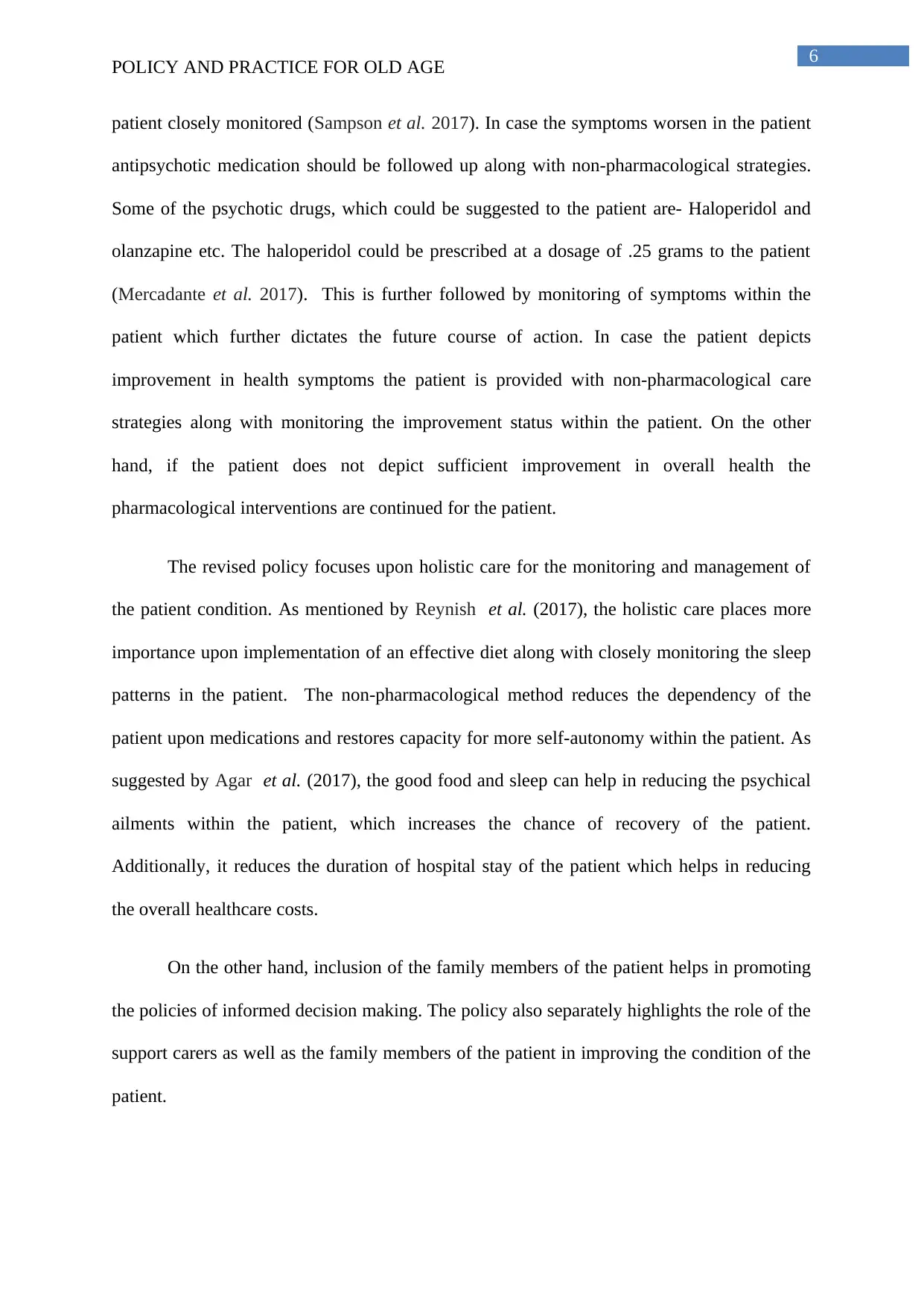
6
POLICY AND PRACTICE FOR OLD AGE
patient closely monitored (Sampson et al. 2017). In case the symptoms worsen in the patient
antipsychotic medication should be followed up along with non-pharmacological strategies.
Some of the psychotic drugs, which could be suggested to the patient are- Haloperidol and
olanzapine etc. The haloperidol could be prescribed at a dosage of .25 grams to the patient
(Mercadante et al. 2017). This is further followed by monitoring of symptoms within the
patient which further dictates the future course of action. In case the patient depicts
improvement in health symptoms the patient is provided with non-pharmacological care
strategies along with monitoring the improvement status within the patient. On the other
hand, if the patient does not depict sufficient improvement in overall health the
pharmacological interventions are continued for the patient.
The revised policy focuses upon holistic care for the monitoring and management of
the patient condition. As mentioned by Reynish et al. (2017), the holistic care places more
importance upon implementation of an effective diet along with closely monitoring the sleep
patterns in the patient. The non-pharmacological method reduces the dependency of the
patient upon medications and restores capacity for more self-autonomy within the patient. As
suggested by Agar et al. (2017), the good food and sleep can help in reducing the psychical
ailments within the patient, which increases the chance of recovery of the patient.
Additionally, it reduces the duration of hospital stay of the patient which helps in reducing
the overall healthcare costs.
On the other hand, inclusion of the family members of the patient helps in promoting
the policies of informed decision making. The policy also separately highlights the role of the
support carers as well as the family members of the patient in improving the condition of the
patient.
POLICY AND PRACTICE FOR OLD AGE
patient closely monitored (Sampson et al. 2017). In case the symptoms worsen in the patient
antipsychotic medication should be followed up along with non-pharmacological strategies.
Some of the psychotic drugs, which could be suggested to the patient are- Haloperidol and
olanzapine etc. The haloperidol could be prescribed at a dosage of .25 grams to the patient
(Mercadante et al. 2017). This is further followed by monitoring of symptoms within the
patient which further dictates the future course of action. In case the patient depicts
improvement in health symptoms the patient is provided with non-pharmacological care
strategies along with monitoring the improvement status within the patient. On the other
hand, if the patient does not depict sufficient improvement in overall health the
pharmacological interventions are continued for the patient.
The revised policy focuses upon holistic care for the monitoring and management of
the patient condition. As mentioned by Reynish et al. (2017), the holistic care places more
importance upon implementation of an effective diet along with closely monitoring the sleep
patterns in the patient. The non-pharmacological method reduces the dependency of the
patient upon medications and restores capacity for more self-autonomy within the patient. As
suggested by Agar et al. (2017), the good food and sleep can help in reducing the psychical
ailments within the patient, which increases the chance of recovery of the patient.
Additionally, it reduces the duration of hospital stay of the patient which helps in reducing
the overall healthcare costs.
On the other hand, inclusion of the family members of the patient helps in promoting
the policies of informed decision making. The policy also separately highlights the role of the
support carers as well as the family members of the patient in improving the condition of the
patient.
Paraphrase This Document
Need a fresh take? Get an instant paraphrase of this document with our AI Paraphraser
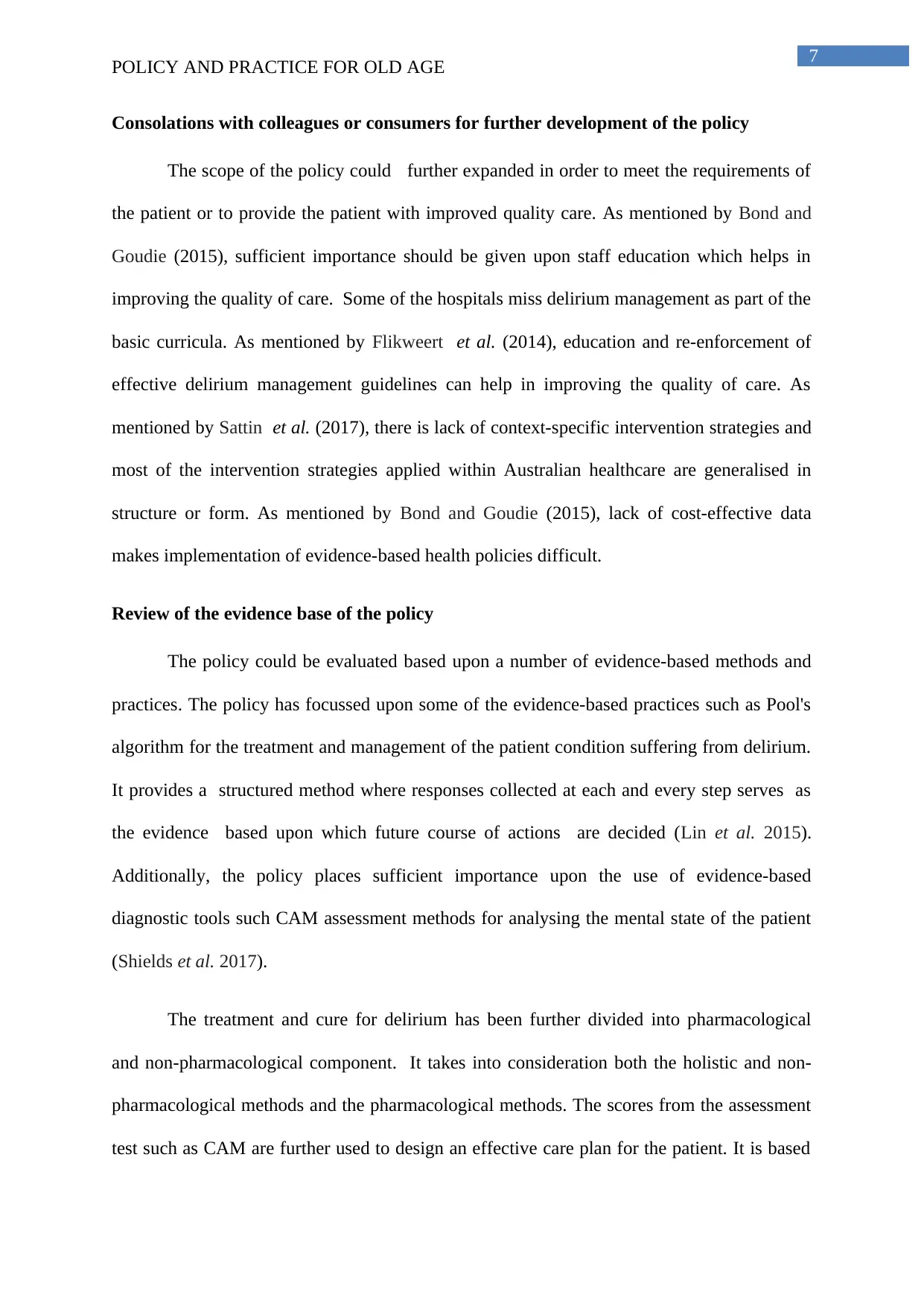
7
POLICY AND PRACTICE FOR OLD AGE
Consolations with colleagues or consumers for further development of the policy
The scope of the policy could further expanded in order to meet the requirements of
the patient or to provide the patient with improved quality care. As mentioned by Bond and
Goudie (2015), sufficient importance should be given upon staff education which helps in
improving the quality of care. Some of the hospitals miss delirium management as part of the
basic curricula. As mentioned by Flikweert et al. (2014), education and re-enforcement of
effective delirium management guidelines can help in improving the quality of care. As
mentioned by Sattin et al. (2017), there is lack of context-specific intervention strategies and
most of the intervention strategies applied within Australian healthcare are generalised in
structure or form. As mentioned by Bond and Goudie (2015), lack of cost-effective data
makes implementation of evidence-based health policies difficult.
Review of the evidence base of the policy
The policy could be evaluated based upon a number of evidence-based methods and
practices. The policy has focussed upon some of the evidence-based practices such as Pool's
algorithm for the treatment and management of the patient condition suffering from delirium.
It provides a structured method where responses collected at each and every step serves as
the evidence based upon which future course of actions are decided (Lin et al. 2015).
Additionally, the policy places sufficient importance upon the use of evidence-based
diagnostic tools such CAM assessment methods for analysing the mental state of the patient
(Shields et al. 2017).
The treatment and cure for delirium has been further divided into pharmacological
and non-pharmacological component. It takes into consideration both the holistic and non-
pharmacological methods and the pharmacological methods. The scores from the assessment
test such as CAM are further used to design an effective care plan for the patient. It is based
POLICY AND PRACTICE FOR OLD AGE
Consolations with colleagues or consumers for further development of the policy
The scope of the policy could further expanded in order to meet the requirements of
the patient or to provide the patient with improved quality care. As mentioned by Bond and
Goudie (2015), sufficient importance should be given upon staff education which helps in
improving the quality of care. Some of the hospitals miss delirium management as part of the
basic curricula. As mentioned by Flikweert et al. (2014), education and re-enforcement of
effective delirium management guidelines can help in improving the quality of care. As
mentioned by Sattin et al. (2017), there is lack of context-specific intervention strategies and
most of the intervention strategies applied within Australian healthcare are generalised in
structure or form. As mentioned by Bond and Goudie (2015), lack of cost-effective data
makes implementation of evidence-based health policies difficult.
Review of the evidence base of the policy
The policy could be evaluated based upon a number of evidence-based methods and
practices. The policy has focussed upon some of the evidence-based practices such as Pool's
algorithm for the treatment and management of the patient condition suffering from delirium.
It provides a structured method where responses collected at each and every step serves as
the evidence based upon which future course of actions are decided (Lin et al. 2015).
Additionally, the policy places sufficient importance upon the use of evidence-based
diagnostic tools such CAM assessment methods for analysing the mental state of the patient
(Shields et al. 2017).
The treatment and cure for delirium has been further divided into pharmacological
and non-pharmacological component. It takes into consideration both the holistic and non-
pharmacological methods and the pharmacological methods. The scores from the assessment
test such as CAM are further used to design an effective care plan for the patient. It is based

8
POLICY AND PRACTICE FOR OLD AGE
upon the assessment scores that the future mode of action is decided. However, there are
limitations as the policy lacks specific care structure and follows a generalised care module.
As argued by Page and Ely (2015), there may be underlying causes for the development of
mental delirium within people. Most of the times, they could be associated with progressive
Alzheimer’s or lesions caused due to cerebrovascular attack.
Recommendations to measure successful implementation of the policy
A number of recommendations could be suggested over here in order to provide the
patient with optimum support. Some of these are implementation of person-centred approach
and policy of informed decision making. For example, the patients suffering from mental
delirium often depict violent or aggressive behaviour. In this case , the involvement of the
family members are important as having a trustworthy person around can make the patient
cooperate with the support carers effectively. Additionally, taking into consideration the
wishes of the patient helps in the promotion of sufficient autonomy in the patients. The
involvement of the family members can also help in promoting the policy of informed
decision making, as sometimes the patient themselves lack the capability of making effective
decisions (Zaal et al. 2015).
Additionally, the government based policies reviewed over here fails to take into
consideration the specialised care needs of the patient. Hence, patient-specific care and
support policies need to be designed. Additionally, sufficient amount of staff training needs
to be implemented who could help in generating sufficient awareness regarding delirium care
and treatment within the elderly. Thus, implementing need-based training can also help in
improving the skills sets of the hospitals staffs.
POLICY AND PRACTICE FOR OLD AGE
upon the assessment scores that the future mode of action is decided. However, there are
limitations as the policy lacks specific care structure and follows a generalised care module.
As argued by Page and Ely (2015), there may be underlying causes for the development of
mental delirium within people. Most of the times, they could be associated with progressive
Alzheimer’s or lesions caused due to cerebrovascular attack.
Recommendations to measure successful implementation of the policy
A number of recommendations could be suggested over here in order to provide the
patient with optimum support. Some of these are implementation of person-centred approach
and policy of informed decision making. For example, the patients suffering from mental
delirium often depict violent or aggressive behaviour. In this case , the involvement of the
family members are important as having a trustworthy person around can make the patient
cooperate with the support carers effectively. Additionally, taking into consideration the
wishes of the patient helps in the promotion of sufficient autonomy in the patients. The
involvement of the family members can also help in promoting the policy of informed
decision making, as sometimes the patient themselves lack the capability of making effective
decisions (Zaal et al. 2015).
Additionally, the government based policies reviewed over here fails to take into
consideration the specialised care needs of the patient. Hence, patient-specific care and
support policies need to be designed. Additionally, sufficient amount of staff training needs
to be implemented who could help in generating sufficient awareness regarding delirium care
and treatment within the elderly. Thus, implementing need-based training can also help in
improving the skills sets of the hospitals staffs.
⊘ This is a preview!⊘
Do you want full access?
Subscribe today to unlock all pages.

Trusted by 1+ million students worldwide
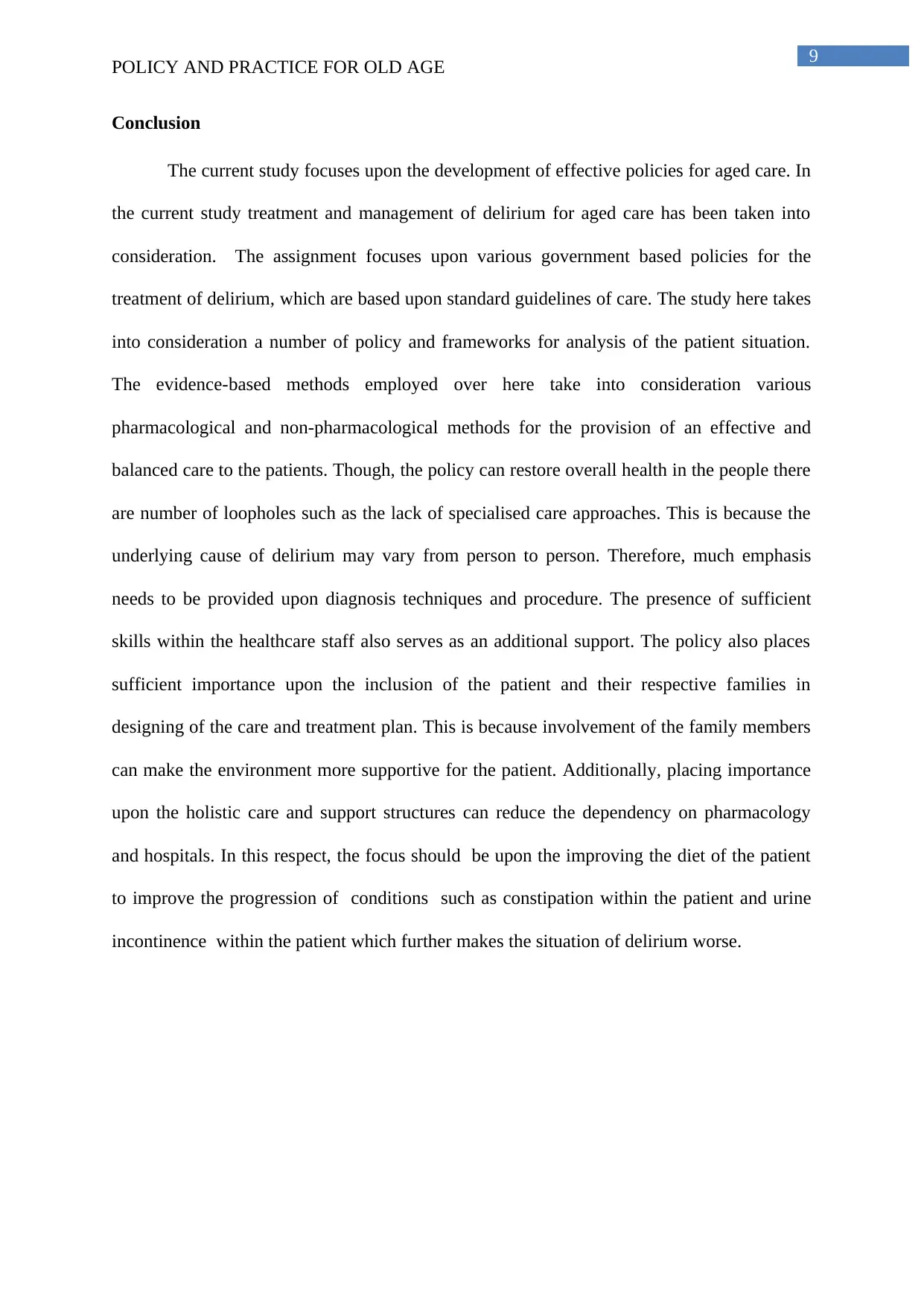
9
POLICY AND PRACTICE FOR OLD AGE
Conclusion
The current study focuses upon the development of effective policies for aged care. In
the current study treatment and management of delirium for aged care has been taken into
consideration. The assignment focuses upon various government based policies for the
treatment of delirium, which are based upon standard guidelines of care. The study here takes
into consideration a number of policy and frameworks for analysis of the patient situation.
The evidence-based methods employed over here take into consideration various
pharmacological and non-pharmacological methods for the provision of an effective and
balanced care to the patients. Though, the policy can restore overall health in the people there
are number of loopholes such as the lack of specialised care approaches. This is because the
underlying cause of delirium may vary from person to person. Therefore, much emphasis
needs to be provided upon diagnosis techniques and procedure. The presence of sufficient
skills within the healthcare staff also serves as an additional support. The policy also places
sufficient importance upon the inclusion of the patient and their respective families in
designing of the care and treatment plan. This is because involvement of the family members
can make the environment more supportive for the patient. Additionally, placing importance
upon the holistic care and support structures can reduce the dependency on pharmacology
and hospitals. In this respect, the focus should be upon the improving the diet of the patient
to improve the progression of conditions such as constipation within the patient and urine
incontinence within the patient which further makes the situation of delirium worse.
POLICY AND PRACTICE FOR OLD AGE
Conclusion
The current study focuses upon the development of effective policies for aged care. In
the current study treatment and management of delirium for aged care has been taken into
consideration. The assignment focuses upon various government based policies for the
treatment of delirium, which are based upon standard guidelines of care. The study here takes
into consideration a number of policy and frameworks for analysis of the patient situation.
The evidence-based methods employed over here take into consideration various
pharmacological and non-pharmacological methods for the provision of an effective and
balanced care to the patients. Though, the policy can restore overall health in the people there
are number of loopholes such as the lack of specialised care approaches. This is because the
underlying cause of delirium may vary from person to person. Therefore, much emphasis
needs to be provided upon diagnosis techniques and procedure. The presence of sufficient
skills within the healthcare staff also serves as an additional support. The policy also places
sufficient importance upon the inclusion of the patient and their respective families in
designing of the care and treatment plan. This is because involvement of the family members
can make the environment more supportive for the patient. Additionally, placing importance
upon the holistic care and support structures can reduce the dependency on pharmacology
and hospitals. In this respect, the focus should be upon the improving the diet of the patient
to improve the progression of conditions such as constipation within the patient and urine
incontinence within the patient which further makes the situation of delirium worse.
Paraphrase This Document
Need a fresh take? Get an instant paraphrase of this document with our AI Paraphraser
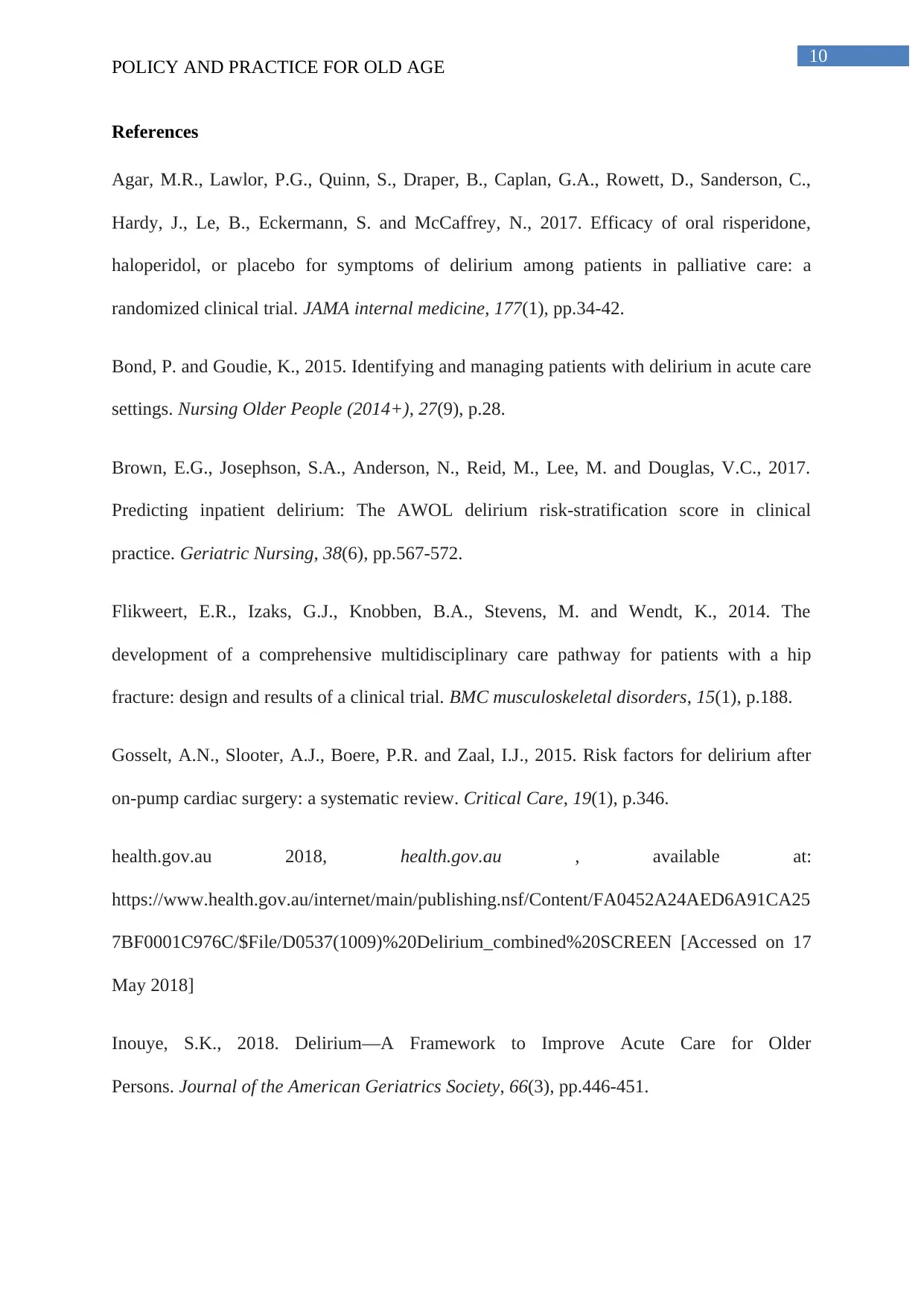
10
POLICY AND PRACTICE FOR OLD AGE
References
Agar, M.R., Lawlor, P.G., Quinn, S., Draper, B., Caplan, G.A., Rowett, D., Sanderson, C.,
Hardy, J., Le, B., Eckermann, S. and McCaffrey, N., 2017. Efficacy of oral risperidone,
haloperidol, or placebo for symptoms of delirium among patients in palliative care: a
randomized clinical trial. JAMA internal medicine, 177(1), pp.34-42.
Bond, P. and Goudie, K., 2015. Identifying and managing patients with delirium in acute care
settings. Nursing Older People (2014+), 27(9), p.28.
Brown, E.G., Josephson, S.A., Anderson, N., Reid, M., Lee, M. and Douglas, V.C., 2017.
Predicting inpatient delirium: The AWOL delirium risk-stratification score in clinical
practice. Geriatric Nursing, 38(6), pp.567-572.
Flikweert, E.R., Izaks, G.J., Knobben, B.A., Stevens, M. and Wendt, K., 2014. The
development of a comprehensive multidisciplinary care pathway for patients with a hip
fracture: design and results of a clinical trial. BMC musculoskeletal disorders, 15(1), p.188.
Gosselt, A.N., Slooter, A.J., Boere, P.R. and Zaal, I.J., 2015. Risk factors for delirium after
on-pump cardiac surgery: a systematic review. Critical Care, 19(1), p.346.
health.gov.au 2018, health.gov.au , available at:
https://www.health.gov.au/internet/main/publishing.nsf/Content/FA0452A24AED6A91CA25
7BF0001C976C/$File/D0537(1009)%20Delirium_combined%20SCREEN [Accessed on 17
May 2018]
Inouye, S.K., 2018. Delirium—A Framework to Improve Acute Care for Older
Persons. Journal of the American Geriatrics Society, 66(3), pp.446-451.
POLICY AND PRACTICE FOR OLD AGE
References
Agar, M.R., Lawlor, P.G., Quinn, S., Draper, B., Caplan, G.A., Rowett, D., Sanderson, C.,
Hardy, J., Le, B., Eckermann, S. and McCaffrey, N., 2017. Efficacy of oral risperidone,
haloperidol, or placebo for symptoms of delirium among patients in palliative care: a
randomized clinical trial. JAMA internal medicine, 177(1), pp.34-42.
Bond, P. and Goudie, K., 2015. Identifying and managing patients with delirium in acute care
settings. Nursing Older People (2014+), 27(9), p.28.
Brown, E.G., Josephson, S.A., Anderson, N., Reid, M., Lee, M. and Douglas, V.C., 2017.
Predicting inpatient delirium: The AWOL delirium risk-stratification score in clinical
practice. Geriatric Nursing, 38(6), pp.567-572.
Flikweert, E.R., Izaks, G.J., Knobben, B.A., Stevens, M. and Wendt, K., 2014. The
development of a comprehensive multidisciplinary care pathway for patients with a hip
fracture: design and results of a clinical trial. BMC musculoskeletal disorders, 15(1), p.188.
Gosselt, A.N., Slooter, A.J., Boere, P.R. and Zaal, I.J., 2015. Risk factors for delirium after
on-pump cardiac surgery: a systematic review. Critical Care, 19(1), p.346.
health.gov.au 2018, health.gov.au , available at:
https://www.health.gov.au/internet/main/publishing.nsf/Content/FA0452A24AED6A91CA25
7BF0001C976C/$File/D0537(1009)%20Delirium_combined%20SCREEN [Accessed on 17
May 2018]
Inouye, S.K., 2018. Delirium—A Framework to Improve Acute Care for Older
Persons. Journal of the American Geriatrics Society, 66(3), pp.446-451.

11
POLICY AND PRACTICE FOR OLD AGE
Lamond, E., Murray, S. and Gibson, C.E., 2018. Delirium screening in intensive care: A life-
saving opportunity. Intensive and Critical Care Nursing, 44, pp.105-109.
Lin, W.L., Chen, Y.F. and Wang, J., 2015. Factors associated with the development of
delirium in elderly patients in intensive care units. Journal of Nursing Research, 23(4),
pp.322-329.
Maldonado, J.R., 2013. Neuropathogenesis of delirium: review of current etiologic theories
and common pathways. The American Journal of Geriatric Psychiatry, 21(12), pp.1190-
1222.
Mercadante, S., Adile, C., Ferrera, P., Cortegiani, A. and Casuccio, A., 2017. Delirium
assessed by Memorial Delirium Assessment Scale in advanced cancer patients admitted to an
acute palliative/supportive care unit. Current medical research and opinion, 33(7), pp.1303-
1308.
Mumford, V., Kulh, M.A., Hughes, C., Braithwaite, J. and Westbrook, J., 2018. Controlled
pre-post, mixed-methods study to determine the effectiveness of a national delirium clinical
care standard to improve the diagnosis and care of patients with delirium in Australian
hospitals: a protocol. BMJ open, 8(1), p.e019423.
Oh, E.S., Fong, T.G., Hshieh, T.T. and Inouye, S.K., 2017. Delirium in Older Persons:
Advances in Diagnosis and Treatment. Jama, 318(12), pp.1161-1174.
Page, V.J. and Ely, E.W., 2015. Delirium in critical care. Cambridge University Press.
Pendlebury, S.T., Lovett, N.G., Smith, S.C., Wharton, R. and Rothwell, P.M., 2016. Delirium
risk stratification in consecutive unselected admissions to acute medicine: validation of a
susceptibility score based on factors identified externally in pooled data for use at entry to the
acute care pathway. Age and ageing, 46(2), pp.226-231.
POLICY AND PRACTICE FOR OLD AGE
Lamond, E., Murray, S. and Gibson, C.E., 2018. Delirium screening in intensive care: A life-
saving opportunity. Intensive and Critical Care Nursing, 44, pp.105-109.
Lin, W.L., Chen, Y.F. and Wang, J., 2015. Factors associated with the development of
delirium in elderly patients in intensive care units. Journal of Nursing Research, 23(4),
pp.322-329.
Maldonado, J.R., 2013. Neuropathogenesis of delirium: review of current etiologic theories
and common pathways. The American Journal of Geriatric Psychiatry, 21(12), pp.1190-
1222.
Mercadante, S., Adile, C., Ferrera, P., Cortegiani, A. and Casuccio, A., 2017. Delirium
assessed by Memorial Delirium Assessment Scale in advanced cancer patients admitted to an
acute palliative/supportive care unit. Current medical research and opinion, 33(7), pp.1303-
1308.
Mumford, V., Kulh, M.A., Hughes, C., Braithwaite, J. and Westbrook, J., 2018. Controlled
pre-post, mixed-methods study to determine the effectiveness of a national delirium clinical
care standard to improve the diagnosis and care of patients with delirium in Australian
hospitals: a protocol. BMJ open, 8(1), p.e019423.
Oh, E.S., Fong, T.G., Hshieh, T.T. and Inouye, S.K., 2017. Delirium in Older Persons:
Advances in Diagnosis and Treatment. Jama, 318(12), pp.1161-1174.
Page, V.J. and Ely, E.W., 2015. Delirium in critical care. Cambridge University Press.
Pendlebury, S.T., Lovett, N.G., Smith, S.C., Wharton, R. and Rothwell, P.M., 2016. Delirium
risk stratification in consecutive unselected admissions to acute medicine: validation of a
susceptibility score based on factors identified externally in pooled data for use at entry to the
acute care pathway. Age and ageing, 46(2), pp.226-231.
⊘ This is a preview!⊘
Do you want full access?
Subscribe today to unlock all pages.

Trusted by 1+ million students worldwide
1 out of 19
Related Documents
Your All-in-One AI-Powered Toolkit for Academic Success.
+13062052269
info@desklib.com
Available 24*7 on WhatsApp / Email
![[object Object]](/_next/static/media/star-bottom.7253800d.svg)
Unlock your academic potential
Copyright © 2020–2025 A2Z Services. All Rights Reserved. Developed and managed by ZUCOL.





